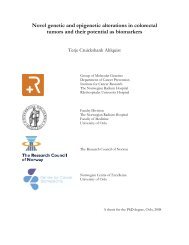Preface - Ous-research.no
Preface - Ous-research.no
Preface - Ous-research.no
You also want an ePaper? Increase the reach of your titles
YUMPU automatically turns print PDFs into web optimized ePapers that Google loves.
Cell Transplantation<br />
Figure 3. Effects of glucocorticoids (GC) on insulin secretion.<br />
emphasis on their influence on insulin metabolism in<br />
human islets. The agents that are tested are cyclosporine A,<br />
tacrolimus, rapamycin, daclizumab, mycophe<strong>no</strong>late mofetil,<br />
FTY 720, LEA 29 and the glucocorticoid Solu-Medrol (Fig. 3).<br />
Each drug is added to human islets in culture medium at<br />
four different concentrations in order to establish the doseresponse<br />
relationship. The effect on islets is analysed regarding<br />
insulin secretion, expression of TF, MCP-1 and TNF-alfa,<br />
mRNA content, and apoptotic genes (Siva (CD27BP), TNFR<br />
1, TNFR2) at different time points after incubation. Specifically,<br />
our data have shown that glucocorticoids induce a<br />
marked reduction of TF mRNA levels which correlates to the<br />
strength of IBMIR and subsequently, the success rate of islet<br />
transplantation. Furthermore, the data show that a negative<br />
influence of glucocorticoids on insulin secretion early<br />
after incubation of human islets is completely reversed on<br />
day 7 (see fig.). This suggests that brief exposure of glucocorticoids<br />
to islets pretransplant suppresses IBMIR and aid<br />
engraftment of transplanted islets.<br />
Several other anti-inflammatory compounds have been<br />
tested such as resolvin E1 and the LXR-agonist GW3965.<br />
Currently, the effects of the IL-1β receptor antagonist<br />
Anakinra and the anti-IL-6 receptor mo<strong>no</strong>clonal antibody<br />
Tocilizumab on islets are investigated. These studies are<br />
defined in a PhD-project for dr. Afaf Sahraoui.<br />
2.2 Whole-blood tubing loop system<br />
Many of the immu<strong>no</strong>suppressive agents (e.g. calcineurine<br />
inhibitors) are largely bound to erythrocytes in vivo. Due to<br />
the IBMIR effect it has been shown that a large number of<br />
transplanted islets rapidly are trapped in clots of erythrocytes<br />
containing high concentrations of the immu<strong>no</strong>suppressive<br />
drug. We have postulated that a slow release of the<br />
drug to the islets will ensue. To test this slow-release effect,<br />
islets (4000 IEQ) are suspended in 6 whole-blood tubing<br />
loops (Fig. 4) and drugs are added to the loops at different<br />
time points i.e. 0, 30, 60, 120 and 240 minutes<br />
Figure 4. The whole-blood tubing loop system.<br />
2.3. Intracellular regulation of immu<strong>no</strong>suppressive<br />
drugs in human islets<br />
Together with the i2mc <strong>research</strong> group, headed by Prof.<br />
Stein Bergan we are investigate the pharmacokinetics, pharmacodynamics<br />
and pharmacoge<strong>no</strong>mics of the immu<strong>no</strong>suppressive<br />
drugs in human islets.<br />
Project 3. To explore and develop striated musculature<br />
as an alternative site for islet transplantation<br />
Intraportal transplantation of islets is the most common method<br />
for islet allo- and auto transplantation. However, functional<br />
and experimental studies suggest that a large part<br />
of the intraportal transplanted islets are destroyed shortly<br />
after infusion, due to islet-blood interactions. In addition, it<br />
has been suggested that intrahepatic islets are exposed to<br />
high concentrations of diabetogenic immu<strong>no</strong>suppressive<br />
drugs, nutrients and gut hormones. This may lead to hyper<br />
secretion of undiluted insulin into surrounding hepatocytes<br />
and focal steatosis. Steatosis following islet transplantation<br />
may cause islet lipotoxicity and eventually be a risk factor<br />
for the development of ade<strong>no</strong>mas in the liver.<br />
Finally, due to procedural risks,<br />
it has been difficult to obtain<br />
the serial biopsies necessary for<br />
characterization of islet engraftment<br />
or rejection in the liver. For<br />
these reasons, development of<br />
an alternative site for islet transplantation<br />
has been suggested to<br />
be an important factor for further<br />
progress in the field. Although<br />
porcine islets could be an unlimi-<br />
Figure 5. The musculature islet transplantation<br />
site.<br />
34
















